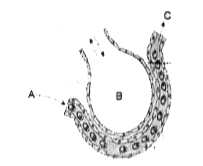Carbon dioxide (CO) diffuses into blood from tissue site and passes to alveolar site in the form of
bicarbonate: 70%
bicarbonate: 20-25%
carbamino haemoglobin: 60-70%
carbamino haemoglobin: 7%
The correct Answer is:A
To answer the question "Carbon dioxide (CO2) diffuses into blood from tissue site and passes to alveolar site in the form of," we need to understand how carbon dioxide is transported in the blood. Here’s a step-by-step solution:
1. Understanding CO2 Diffusion: Carbon dioxide (CO2) is produced in the tissues as a byproduct of cellular respiration. It diffuses from the tissue cells into the blood.
2. Transport Mechanisms: Once in the blood, CO2 is transported in three main forms:
- Dissolved in Plasma: A small amount of CO2 (about 7-10%) is dissolved directly in the plasma.
- Carbamino Compounds: About 20-25% of CO2 binds to hemoglobin and other proteins to form carbamino compounds (carbaminohemoglobin).
- Bicarbonate Ions: The majority of CO2 (approximately 70%) is converted into bicarbonate ions (HCO3-) in the red blood cells.
3. Conversion to Bicarbonate: The conversion of CO2 to bicarbonate is facilitated by the enzyme carbonic anhydrase, which catalyzes the reaction:
CO2+H2O↔H2CO3↔H++HCO3−
This reaction allows CO2 to be transported efficiently in the blood.
4. Final Transport to Alveoli: When blood reaches the alveoli in the lungs, CO2 is released from bicarbonate and carbamino compounds, diffusing back into the alveoli to be exhaled.
5. Conclusion: Therefore, the primary form in which CO2 is transported from tissues to the alveolar site is as bicarbonate ions.
Answer:
Carbon dioxide (CO2) diffuses into blood from tissue sites and passes to alveolar sites primarily in the form of bicarbonate ions (approximately 70%).
---
- Dissolved in Plasma: A small amount of CO2 (about 7-10%) is dissolved directly in the plasma.
- Carbamino Compounds: About 20-25% of CO2 binds to hemoglobin and other proteins to form carbamino compounds (carbaminohemoglobin).
- Bicarbonate Ions: The majority of CO2 (approximately 70%) is converted into bicarbonate ions (HCO3-) in the red blood cells.
CO2+H2O↔H2CO3↔H++HCO3−
This reaction allows CO2 to be transported efficiently in the blood.
Carbon dioxide (CO2) diffuses into blood from tissue sites and passes to alveolar sites primarily in the form of bicarbonate ions (approximately 70%).
টপার এই প্রশ্নগুলো সমাধান করেছে
- BREATHING AND EXCHANGE OF GASES BOOK - AAKASH SERIESCHAPTER - BREATHING AND EXCHANGE OF GASES EXERCISE - EXERCISE-I (Regulation of Respiration)
15 Videos
- BREATHING AND EXCHANGE OF GASES BOOK - AAKASH SERIESCHAPTER - BREATHING AND EXCHANGE OF GASES EXERCISE - EXERCISE-I (Disorders of Respiratory System)
9 Videos
- BREATHING AND EXCHANGE OF GASES BOOK - AAKASH SERIESCHAPTER - BREATHING AND EXCHANGE OF GASES EXERCISE - EXERCISE-I (Exchange of Gases)
21 Videos
- BODY FLUIDS AND CIRCULATIONBOOK - AAKASH SERIESCHAPTER - BODY FLUIDS AND CIRCULATIONEXERCISE - Exercise -III (Previous AIPMT/NEET Questions)
35 Videos
- CHEMICAL COORDINATION AND INTERGRATIONBOOK - AAKASH SERIESCHAPTER - CHEMICAL COORDINATION AND INTERGRATIONEXERCISE - Exercise-III (previous AIPMT/NEET questions)
41 Videos
সম্পর্কিত প্রশ্ন
Pneumotaxic centre is associated with
View SolutionWhich of the following match is correct?
View SolutionStudy the following diagram and select the option that correctly identifies the partial pressure of oxygen at A, B and C.


View SolutionThe hepatic portal vein drains blood to liver form
View SolutionHypersecretion of Growth Hormone in adults does not cause further increase in height because
View SolutionWhich is the site of actual diffusion of O2 and C02 between blood and atmospheric air?
View SolutionAt the tissue site where partial pressure of CO_(2) is (a)____ due to (b)____, CO_(2) diffuse into blood and form (c)_____ and (d)__
View SolutionCarbon dioxide is transported in blood in the form of
View Solution__________ form a clot at the site of injury and prevent blood loss
View SolutionThe ............... are the site for exchange of materials between blood and tissues.
View SolutionWhich component of blood blocks the passage of blood from the injured site by forming a blood clot?
View SolutionCarbon dioxide (CO) diffuses into blood from tissue site and passes to alveolar site in the form of
View SolutionBulk of carbon dioxide (CO_2) released from body tissues into the blood is present as
View Solutionशरीर के ऊतकों द्वारा रुधिर में निर्मुक्त की जाने वाली कार्बन डाइऑक्साइड का अधिकांश भाग निम्नलिखित में से किस रूप में उपस्थिरत रखता है-
View SolutionMost carbon dioxide in blood is in the form of:
View SolutionOxygen enters the blood from the alveolar air but carbon dioxide leaves the blood to enter the alveolar air. Explain.
View Solution

